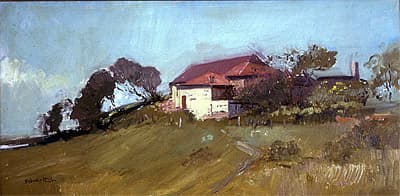
Sydney
LONG
Australia
1871
–
London
1955
England, Europe 1910-21; Australia 1921- 22; England 1922-25; Australia 1925-52; England from 1952
30.1 (h) x 60.7 (w) cm
signed ‘SYDNEY LONG’ lower left Wesfarmers Collection of Australian art, Perth
The sea is largely omitted from this scene of an unnamed, but recognisably Australian, stretch of coastal hinterland. Long is more interested in capturing a sense of the blustery conditions and bright exposure of the coastal landscape and leaves just a sliver of exposed canvas, at the far left of the picture, to indicate by the briefest of suggestions, a distant stretch of water. Loose, deft brushwork and highlights of colour, dashed in to describe the transitory effects of sunlight and wind, suggest that the work is likely to have been painted en plein air, at least in part – outdoors in a gentle, perhaps early evening light, and from a low vantage point on an approach to the cottage.
Applying his paint quickly and decisively, Long has worked wet-in-wet, making compositional adjustments along the way, most clearly to the line and pitch of the roof of the cottage. He has embraced the spontaneity of the sketch from nature, using thin, almost chalky paint to convey the bristling texture of the low coastal trees bending to the force of prevailing winds, while giving the cottage and its dry, grassy setting a more painterly treatment.
In contrast to the stylised imagery of his early, mythical, bush paintings, it is an altogether more domesticated Australian landscape that the older artist, now approaching his 60s, depicts in Seaside cottage. Yet certain of the enduring qualities, for which he is best remembered, exert a subtle influence in this work – especially through the decorative and harmonious arrangement of scenic elements, as well as the expressive handling of the wind gusting through sky, trees and grass. We see the mature artist moving instinctively through his range – seeking from this modest rustic subject a poetic response to the landscape.
Helen Carroll
The sea is largely omitted from this scene of an unnamed, but recognisably Australian, stretch of coastal hinterland. Long is more interested in capturing a sense of the blustery conditions and bright exposure of the coastal landscape and leaves just a sliver of exposed canvas, at the far left of the picture, to indicate by the briefest of suggestions, a distant stretch of water. Loose, deft brushwork and highlights of colour, dashed in to describe the transitory effects of sunlight and wind, suggest that the work is likely to have been painted en plein air, at least in part – outdoors in a gentle, perhaps early evening light, and from a low vantage point on an approach to the cottage.
Applying his paint quickly and decisively, Long has worked wet-in-wet, making compositional adjustments along the way, most clearly to the line and pitch of the roof of the cottage. He has embraced the spontaneity of the sketch from nature, using thin, almost chalky paint to convey the bristling texture of the low coastal trees bending to the force of prevailing winds, while giving the cottage and its dry, grassy setting a more painterly treatment.
In contrast to the stylised imagery of his early, mythical, bush paintings, it is an altogether more domesticated Australian landscape that the older artist, now approaching his 60s, depicts in Seaside cottage. Yet certain of the enduring qualities, for which he is best remembered, exert a subtle influence in this work – especially through the decorative and harmonious arrangement of scenic elements, as well as the expressive handling of the wind gusting through sky, trees and grass. We see the mature artist moving instinctively through his range – seeking from this modest rustic subject a poetic response to the landscape.
Helen Carroll
The sea is largely omitted from this scene of an unnamed, but recognisably Australian, stretch of coastal hinterland. Long is more interested in capturing a sense of the blustery conditions and bright exposure of the coastal landscape and leaves just a sliver of exposed canvas, at the far left of the picture, to indicate by the briefest of suggestions, a distant stretch of water. Loose, deft brushwork and highlights of colour, dashed in to describe the transitory effects of sunlight and wind, suggest that the work is likely to have been painted en plein air, at least in part – outdoors in a gentle, perhaps early evening light, and from a low vantage point on an approach to the cottage.
Applying his paint quickly and decisively, Long has worked wet-in-wet, making compositional adjustments along the way, most clearly to the line and pitch of the roof of the cottage. He has embraced the spontaneity of the sketch from nature, using thin, almost chalky paint to convey the bristling texture of the low coastal trees bending to the force of prevailing winds, while giving the cottage and its dry, grassy setting a more painterly treatment.
In contrast to the stylised imagery of his early, mythical, bush paintings, it is an altogether more domesticated Australian landscape that the older artist, now approaching his 60s, depicts in Seaside cottage. Yet certain of the enduring qualities, for which he is best remembered, exert a subtle influence in this work – especially through the decorative and harmonious arrangement of scenic elements, as well as the expressive handling of the wind gusting through sky, trees and grass. We see the mature artist moving instinctively through his range – seeking from this modest rustic subject a poetic response to the landscape.
Helen Carroll
